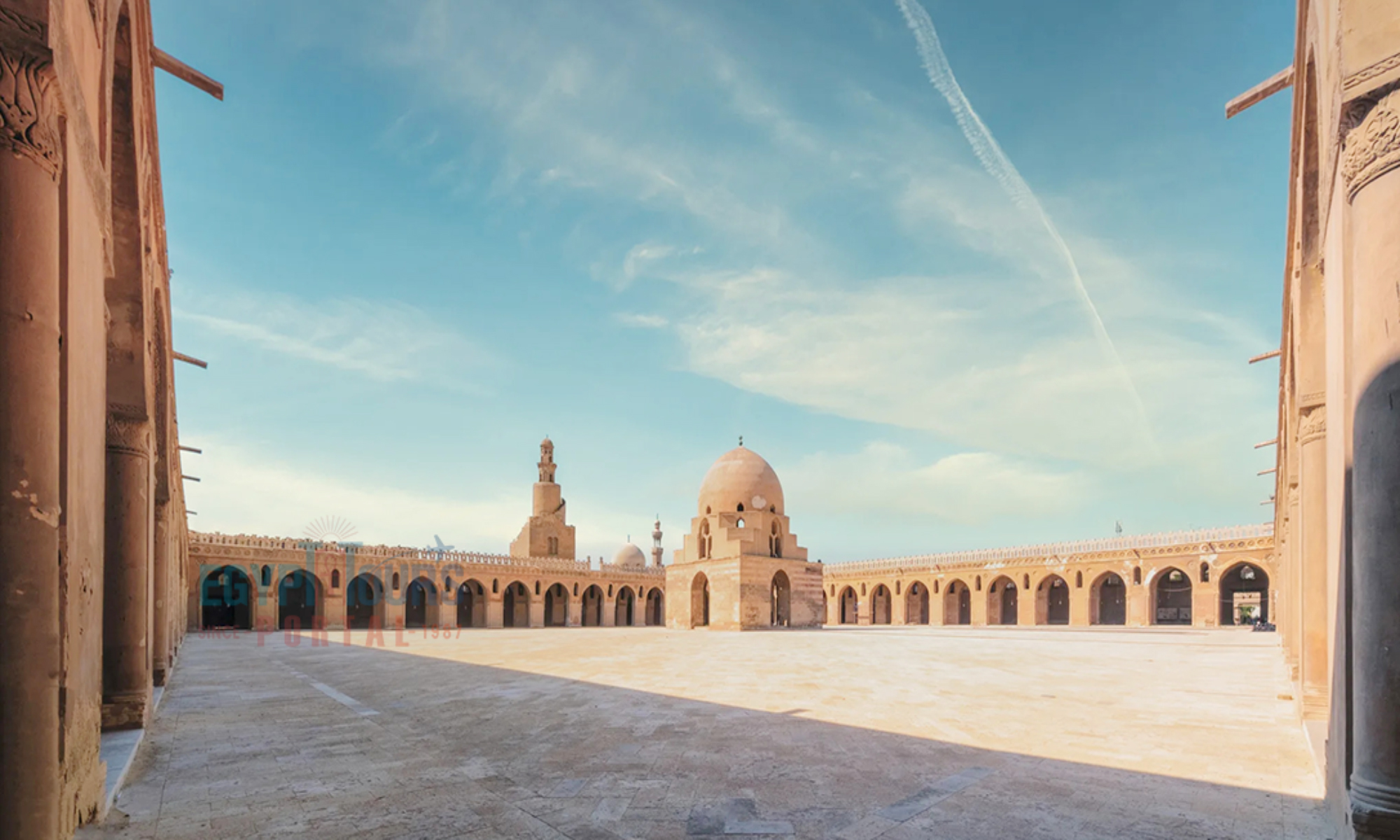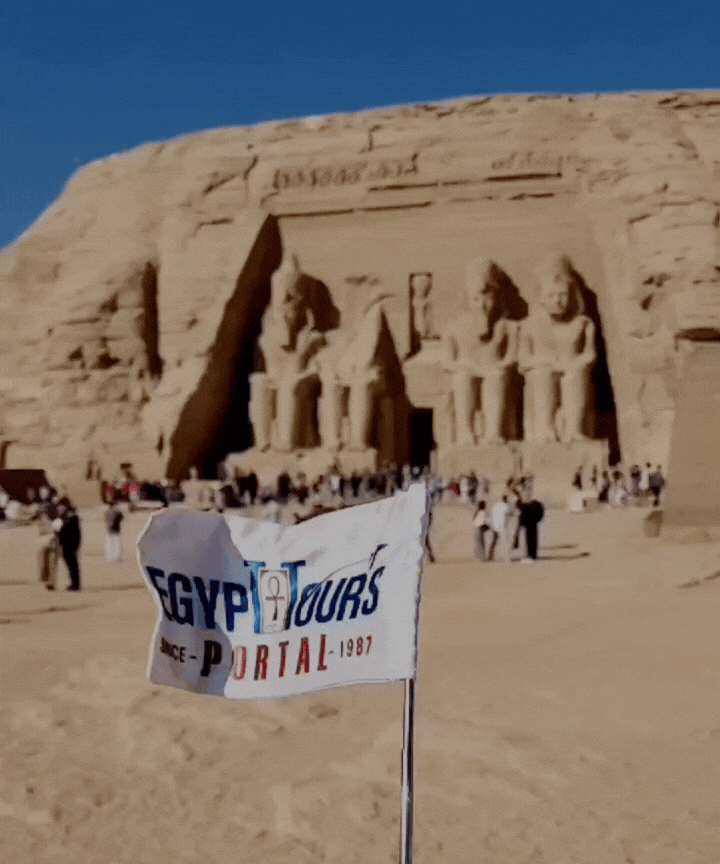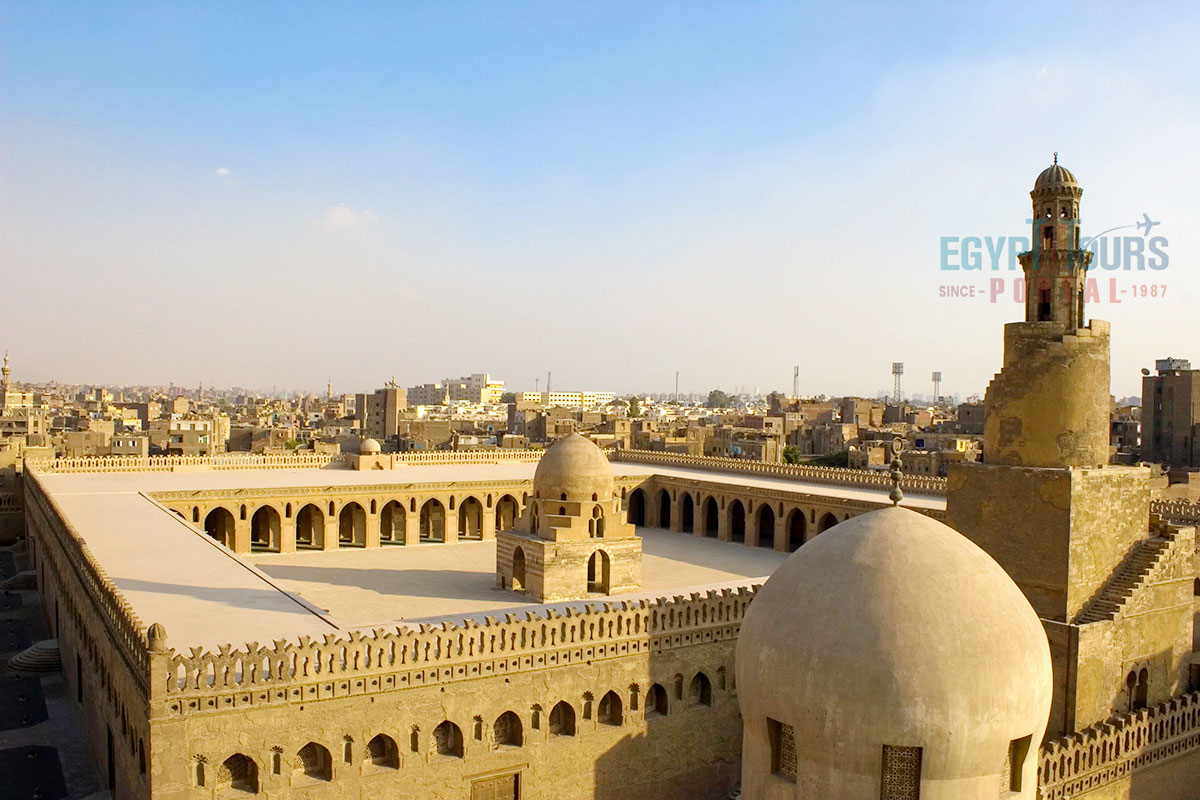The Ibn Tulun Mosque in Islamic Cairo is Egypt’s oldest surviving mosque, built between 876–879 AD by Ahmed Ibn Tulun. Inspired by Iraq’s Great Mosque of Samarra and designed by a Christian architect, it features a rare spiral minaret and expansive mudbrick structure. Positioned atop Jabal Yashkur, it was part of the capital Al-Qata’i and showcases Abbasid influence fused with Egyptian style. Its architectural innovations, like pointed arches and piers, later influenced Gothic design. Still active today, the mosque is a symbol of Egypt’s Tulunid era and a lasting monument to Islamic architectural heritage.


Ibn Tulun Mosque is a sacred monument that radiates divinity and mystery, plus played a vital role in creating a major shift in the architectural spectrum across the globe. The golden city of Cairo is home to the immortal Ibn Tulun mosque, which is known to be the father of inspiration and innovation, as it changed the face of architecture across the entire Islamic world, but was also able to cross to other borders and different cultures.
Every element of this gigantic masterpiece has a story to tell, revealing ancient tales dating for more than a thousand years about how the city of Cairo came into its essence and current artistic aura. This article will come to explore all the reasons and elements relating to this glorious piece of art.

The Ibn Tulun Mosque is located in the Sayyida Zeinab district of historic Islamic Cairo, which is known for its ancient mosques and monuments. The mosque sits on a small hill called Jabal Yashkur (Hill of Thanksgiving), which is traditionally believed to be where Noah’s Ark came to rest after the flood. The mosque’s location is strategic, providing a commanding view of the surrounding area at the time of its construction. It is close to other major historic sites, including the Citadel of Cairo, the Mosque of Sultan Hassan, and many other great monuments.
Discover the incredible architecture of the Islamic heritage of Egypt
Read More
Ibn Tulun mosque is known for being the best-preserved mosque in Egypt, Cairo’s oldest intact functioning Islamic monument, and one of the most important historical and architectural achievements in Muslim civilization. It was built by the Emir Ahmed Ibn Tulun, who ruled Egypt from 868 to 883 A.D under the rule of the Abbasid Caliph.
The mosque was designed by a famous Egyptian Architect called Saiid Ibn Kateb Al-Farghany, who was a Christian Orthodox. After taking control of Egypt, he founded a new city called Al-Qata’I on a rocky outcrop said to be the landing site of Noah’s Ark. In May 879 C.E., the construction of a palace complex, a hippodrome, a spiral minaret, and a large mosque named after him was completed.

Ibn Tulun mosque is not an ordinary mosque; it’s one of the oldest, largest, and best-preserved mosques in the world, as it contains an unbelievable amount of history, allure, and elegance from the early Islamic age. Ibn Tulun mosque is built on a 26,318 sqm area, which makes it the third-largest mosque in the world.
Ibn Tulun drew inspiration from the ancient mosque of Samarra (Iraq) in his homeland and from the ancient Lighthouse of Alexandria, as shown in the minaret. The mosque was constructed in the Samarran style with Abbasid constructions, plus constructed around a courtyard, with one covered hall on each of the four sides, where the largest one is on the side of the qibla, or direction of Mecca.
The mosque has a square shape 162 meters long, a total number of 42 doors, and consists of three main sections, the praying hall which holds the breathtaking mihrab and minibar, the beautifully decorated courtyard, and the open extensions (wall battlements) that surround the mosque and works as a barrier between the streets and the religious space inside.
The mosque and the arches of the courtyard are decorated with some impressive designs in carved stucco and wood. The internal decoration of the mosque was out of this world, as some of the decoration patterns can be traced back to the Hellenic and Sassanian eras, on the windows and the arcades, which are a combination of floral and geometrical patterns. Ibn Tulun mosque also had magical calligraphy works on the high section of the walls, the internal frames of the windows, and the mihrab.
The minaret is 170 ft in height and modeled after the minarets of the famous city of Samarra, with a beautiful spiral staircase around the outside, which makes it the only one of its kind in Egypt. The mosque was restored a couple of times throughout history, notably between 1296 and 1299 A.D, and most recently in 1890 when the entire mosque was completely restored.

Ibn Tulun Mosque is a rare example where Europeans openly admitted its profound influence on the development of architecture beyond Islamic boundaries, as it was the first recorded example of the systematic adoption of piers to carry the arcades and the roof as an alternative to columns. The mosque was also the first building where the pointed arch was used constructively and systematically. Elements as the pointed arch, the wall battlements, and the piers became essential ingredients of Gothic architecture.

Ahmed Ibn Tulun was a Turkish military leader who was born in 835 AD, founded the Tulunid dynasty in Egypt, and ruled from 868 to he passed away in 884 AD. He was sent by the Abbasid caliph in Baghdad to govern Egypt, but he gradually established his own independent rule, making Egypt a center of power. Ibn Tulun Mosque is known for his military skills, administrative abilities, and the development of Egypt’s infrastructure, which led to a period of prosperity during his reign.
He is famous for his contribution to architecture, most notably the construction of the Ibn Tulun Mosque, which was built between 876 and 879 AD. This mosque was intended to serve as the congregational mosque for the new capital, Al-Qata'i, which is found north of the old capital, Fustat, which was made by Ibn Tulun as his administrative center. Although Al-Qata'i was destroyed after his death, the mosque survived and stands as one of the oldest and largest in Cairo.
Ibn Tulun's rule marked an era of economic growth, urban expansion, and relative independence from the Abbasids, positioning Egypt as a semi-autonomous state within the Islamic world. He was also a patron of the arts and sciences, and his legacy lives on through the architecture he commissioned, especially the Ibn Tulun Mosque.
The mosque of Ibn Tulun is considered to be one of the most famous Cairo tourist attractions, which can’t be missed during your Egypt vacation. If you want to take an exploring tour that includes visiting Ibn Tulun mosque, then you have to check our Egypt tours and nile river cruise, where you will find the best tailor-made tour to all the Egyptian attractions in Cairo, Alexandria, Luxor, and Aswan.
Cairo Stopover Tour Cairo stopover tour is the ultimate portal for every British tra...
Tour Location: Cairo/Giza...
Day Tour in Cairo and the Pyramids For British Travelers Day Tour in Cairo and The ...
Tour Location: Cairo/Giza...
Day Trip to Pyramids from Cairo for British Travelers Day trip to the Pyramids from ...
Tour Location: Giza...
Saqqara & Memphis Tour from Cairo For British Travelers Saqqara & Memphis to...
Tour Location: Memphis and Sakkara...
The Ibn Tulun Mosque is one of the largest mosques in Cairo in terms of land area, covering an area of approximately 26,318 square meters (around 6.5 acres). It is one of the oldest mosques in Egypt and Africa, and its large courtyard and expansive prayer hall can accommodate thousands of worshippers at once. The mosque’s central courtyard, surrounded by arcades, is nearly 92 meters long and 91 meters wide.
The Ibn Tulun Mosque was completed in 879 AD, making it over 1,145 years old. It is one of the oldest mosques in Egypt and Africa, still standing in its original form. Built during the Abbasid period under the rule of Ahmad Ibn Tulun, the founder of the Tulunid dynasty, it has survived throughout the centuries with minimal changes.
The mosque follows a traditional Abbasid hypostyle layout. Its main features include:
The Open Courtyard, which is a large open space at the center of the mosque, approximately 92 by 91 meters, is surrounded by covered arcades.
Arcades that surround the courtyard on all four sides are arcades with pointed arches. These arcades are supported by rows of brick piers.
The covered Prayer Hall, which is located on the southern side (the qibla wall), is the largest and most important of the arcades, leading worshippers towards the mihrab, indicating the direction of Mecca.
The mosque has a unique spiral-shaped minaret, possibly inspired by the famous minaret of the Great Mosque of Samarra in Iraq. It offers panoramic views of Cairo.
The mihrab is a niche in the qibla wall, marking the direction of prayer. The mosque’s minbar (pulpit) stands near the mihrab for delivering sermons.
The mosque has an outer enclosure called a ziyāda, which is a buffer zone between the mosque and the surrounding city. This feature provides privacy and extra protection.
The Ibn Tulun Mosque is architecturally significant for its simplicity, vastness, and preservation of classical Islamic design.
The entire country of Egypt deserve to be explored with its every heavenly detail but there are places that must be seen before any other such as the breathtaking Hurghada's red sea, The wonders of Cairo the pyramids of Giza, the great sphinx, the Egyptian Museum, Khan El Khalili Bazaar, the wonders of Luxor like Valley of the Kings, Karnak & Hatshepsut temple and the wonders of Aswan such as Abu Simbel temples, Philea temple, Unfinished obelisk and The Wonders of Alexandria like Qaitbat Citadel, Pompey's Pillar and Alexandria Library. Read more about the best places to visit in Egypt.
If you want to apply for a Visa On Arrival that lasts for 30 days then you should be one of the eligible countries, have a valid passport with at least 6 months remaining and pay 25$ USD in cash, as for the E-Visa for 30 day you should have a valid passport for at least 8 months, complete the online application, pay the e-visa fee then print the e-visa to later be presented to the airport border guard. You could also be one of the lucky ones who can obtain a free visa for 90 days. Read more about Egypt travel visa.
Egypt has a variety of delicious cuisines but we recommend “Ful & Ta’meya (Fava Beans and Falafel)”, Mulukhiya, “Koshary”, a traditional Egyptian pasta dish, and Kebab & Kofta, the Egyptian traditional meat dish.
The best time to travel to Egypt is during the winter from September to April as the climate becomes a little tropical accompanied by a magical atmosphere of warm weather with a winter breeze. You will be notified in the week of your trip if the Climate is unsafe and if any changes have been made.
You should pack everything you could ever need in a small bag so you could move easily between your destinations.
We have been creating the finest vacations for more than 20 years around the most majestic destinations in Egypt. Our staff consists of the best operators, guides and drivers who dedicate all of their time & effort to make you have the perfect vacation. All of our tours are customized by Travel, Financial & Time consultants to fit your every possible need during your vacation. It doesn't go without saying that your safety and comfort are our main priority and all of our resources will be directed to provide the finest atmosphere until you return home.
You will feel safe in Egypt as the current atmosphere of the country is quite peaceful after the government took powerful measures like restructuring the entire tourist police to include all the important and tourist attractions in Egypt. Read more about is it safe to travel to Egypt.
Wear whatever feels right and comfortable. It is advised to wear something light and comfortable footwear like a closed-toe shoe to sustain the terrain of Egypt. Put on sun block during your time in Egypt in the summer to protect yourself from the sun.
The best activity is by far boarding a Nile Cruise between Luxor and Aswan or Vise Versa. Witness the beauty of Egypt from a hot balloon or a plane and try all the delicious Egyptian cuisines and drinks plus shopping in old Cairo. Explore the allure and wonders of the red sea in the magical city resorts of Egypt like Hurghada and many more by diving and snorkeling in the marine life or Hurghada. Behold the mesmerizing western desert by a safari trip under the heavenly Egyptian skies.
There are a lot of public holidays in Egypt too many to count either religious or nation, the most important festivals are the holy month of Ramadan which ends with Eid Al Fitr, Christmas and new years eve. Read more about festivals & publich holidays in Egypt.
Egypt is considered to be one of the most liberal Islamic countries but it has become a little bit conservative in the last couple of decades so it is advised to avoid showing your chest, shoulders or legs below the knees.
Arabic is the official language and Most Egyptians, who live in the cities, speak or understand English or at least some English words or phrases. Fewer Egyptians can speak French, Italian, Spanish, and German. Professional tour guides, who work in the tourism sector, are equipped to handle visitors who cannot speak Arabic and they will speak enough English and other languages to fulfill the needs of all our clients.
The fastest way is a car, of course, a taxi. If you are in Cairo ride a white taxi to move faster or you could board the fastest way of transportation in Egypt metro if the roads are in rush hour.
The temperature in Egypt ranges from 37c to 14 c. Summer in Egypt is somehow hot but sometimes it becomes cold at night and winter is cool and mild. The average of low temperatures vary from 9.5 °C in the wintertime to 23 °C in the summertime and the average high temperatures vary from 17 °C in the wintertime to 32 °C in the summertime. The temperature is moderate all along the coasts.
It is the home of everything a traveler might be looking for from amazing historical sites dating to more than 4000 years to enchanting city resorts & beaches. You will live the vacation you deserve as Egypt has everything you could possibly imagine.









